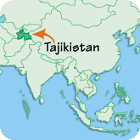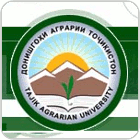The Republic of Tajikistan is a mountainous landlocked country in Central Asia. After independence from the Soviet Union in 1991, Tajikistan suffered from a devastating civil  war which lasted from 1992 to 1997. Since the end of the war, newly-established political stability and foreign aid have allowed the country's economy to grow. Arable area is just 5-6% of the total area of Tajikistan but agriculture accounted for 19% of GDP in 2000. While cotton is the most important commercial crop in Tajikistan, wheat is the most important staple crop.
war which lasted from 1992 to 1997. Since the end of the war, newly-established political stability and foreign aid have allowed the country's economy to grow. Arable area is just 5-6% of the total area of Tajikistan but agriculture accounted for 19% of GDP in 2000. While cotton is the most important commercial crop in Tajikistan, wheat is the most important staple crop.
Most of the Tajik agricultural breeding research centres were established in the early thirties, during the first effort of the Soviet government to promote high-input, intensive, agricultural research in the region. Today the two major research agricultural organizations that carry out crop breeding in Tajikistan: Ziroatkor and Bogparvar Scientific and Production Enterprises (S&PE). They both are public and supervised by the Tajik Academy of Agrarian Sciences, which is subordinated to the Ministry of Agriculture.
Cotton and wheat are bred by most of the institutions due to their importance in the country. Nevertheless several research entities also take care of rice, maize, sorghum, oilseed, forage and grain legume breeding but allocate very little resources for them. As a result of the overall deterioration in the Tajik economy, farmers apply fewer inputs at present as compared with the late eighties. Therefore, some of the field crop and permanent crop breeding programs reported biotic stresses to be higher in priority.
The total number of breeders, as well as the financial resources, has decreased since the dissolution of the Soviet Union. Facilitating access to financial resources and improving necessary infrastructure is considered the most important help that can be provided by the International Community.
Research and education institutes with activities in plant breeding
Public Institutes
 |
Website available in English or Tajik
TAU is under the Ministry of Education and Science. The university has worked on cotton breeding since the 1960s and recently it became involved in wheat breeding. In the 1990s, the university began a biotechnology program, which evolved to a biotechnology institute within the university by 2000. At present, the institute employs biotechnology tools intensively in the virus-free potato seed production, which is funded through a FAO/CIDA program. The research agenda of the university is coordinated with Tajik Academy of Agricultural Sciences.
|
 |
Research Institute of Farming (Scientific and Production Enterprise ZIROATKOR)
No Website Available
Since the late 1980s, RI of Farming is a part of Scientific and Production Enterprise (S&PE) Ziroatkor, which consists of a research institute, field branches, trial stations and experimental farms. Ziroatkor is part of the Tajik Academy of Agricultural Sciences, which is under the umbrella of the Ministry of Agriculture of Tajikistan. The institute was established in 1936 as a dryland agriculture research station, which later evolved to the Research Institute of Farming. It has been involved in crops breeding since the 1950s. The institute worked on a wide range of field crops and vegetables: wheat, rice, barley, maize, sorghum, cotton, chickpea, pea, lentils, soybean, peanut, safflower, flax, sesame, and others. Ziroatkor does not use biotechnology in its research.
|
 |
Vakhsh Branch (Scientific and Production Enterprise ZIROATKOR)
No Website Available
The station was founded in 1930. Soon, it became a major fine-fiber cotton breeding center in Tajikistan. It also maintains breeding programs (mostly variety trials) for small grains (wheat, barley, rye, oats, triticale), sorghum, soybean, bersim clover, Persian clover, lupine, rapeseed, forage beet, mustards and forage maize. Vakhsh Research Station has become affiliated with Ziroatkor Scientific and Production Enterprise since the late eighties. It has never been involved in biotechnology research.
|
 |
Research Institute of Fruit and Vegetable Growing and Viticulture (Scientific and Production Enterprise BOGPARVAR)
No Website Available
RI of Fruit and Vegetable Growing and Viticulture belongs since the late 1980s to Scientific and Production Enterprise Bogparvar. Bogparvar is a large association, which unites a research institute, branches, trial stations and experimental production farms, and is part of Tajik Academy of Agricultural Science. RI of Fruit and Vegetable Growing and Viticulture has been involved in crop breeding since 1936. It is a major breeding centre for fruit and vegetable crops in Tajikistan and works on: potato, onion, garlic, carrot, tomato, cucumber, melons, grape, apple, apricot, peach, citrus (lemon, orange and grapefruit), and subtropical fruits (pomegranate and fig).
|
 |
Soghd Branch (Scientific and Production Enterprise BOGPARVAR)
No Website Available
Soghd Branch became a member of Bogparvar S&PE in the late 1980s. It has been involved in crop breeding research since 1936. It is a major breeding centre for the northern plains of Tajikistan, where fruits, vegetables and grapes are important. The Soghd branch allocated about 10%, 30% and 60 % of the total breeding budget to germplasm enhancement, line development and line valuation, respectively. The branch has not employed biotechnologists.
|
 |
Research Institute of Plant Physiology and Genetics
No Website Available
RI of Plant Physiology and Genetics is part of Tajik Academy of Sciences. It has been involved in crop breeding and biotechnology since 1976 and 1986, respectively. Cotton is the most important target crop of the institute. It has also worked on wheat, triticale, rye and potato. In the late 1980s, RI of Plant Genetics and Breeding emphasized application of physiological traits in selection of cotton, use of tissue culture for clone multiplication and developing virus free germplasm in potato and wide crosses to involve new variability in breeding of triticale and wheat.
|
 |
Research Institute of Plant Physiology and Genetics
No Website Available
RI of Plant Physiology and Genetics is part of Tajik Academy of Sciences. It has been involved in crop breeding and biotechnology since 1976 and 1986, respectively. Cotton is the most important target crop of the institute. It has also worked on wheat, triticale, rye and potato. In the late 1980s, RI of Plant Genetics and Breeding emphasized application of physiological traits in selection of cotton, use of tissue culture for clone multiplication and developing virus free germplasm in potato and wide crosses to involve new variability in breeding of triticale and wheat.
|
 |
Pamir Biological Institute
No Website Available
Pamir Biological Institute is part of Tajik Academy of Sciences. The institute was founded in 1969 on the basis of three research branches/stations of the Tajik Academy of Sciences. Although research of biological resources is the major focus of the institute, it has also been involved in crop breeding since its establishment, when the genetics and breeding laboratory was founded. Its target crops have been wheat, barely, triticale and legumes, especially horse beans. Many local varieties of horse beans are widely spread in the Gorno-Badakhshan region.
|
_______________________________________
Information by David Bedoshvili (2006). - Information based on the Tajikistan's full report from the PBBC survey. Last revised 23-06-2010, GIPB.
 war which lasted from 1992 to 1997. Since the end of the war, newly-established political stability and foreign aid have allowed the country's economy to grow. Arable area is just 5-6% of the total area of Tajikistan but agriculture accounted for 19% of GDP in 2000. While cotton is the most important commercial crop in Tajikistan, wheat is the most important staple crop.
war which lasted from 1992 to 1997. Since the end of the war, newly-established political stability and foreign aid have allowed the country's economy to grow. Arable area is just 5-6% of the total area of Tajikistan but agriculture accounted for 19% of GDP in 2000. While cotton is the most important commercial crop in Tajikistan, wheat is the most important staple crop.







